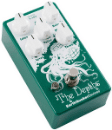
If you are asking yourself what is a guitar stomp box, then this guide will answer all your questions and get you up and running in no time. If you already know about guitar stompboxes, then there’s a lot of information here that can help you become even more knowledgeable.
Once you enter the wonderful world of stomp boxes, there is no turning back, so prepare to have your guitar playing taken to the next level!
So, What Is A Guitar Stomp Box?

As we begin to play guitar, especially the electric guitar, one of the first things to grab our attention are stompboxes (also called stomp boxes)! They are those interesting little units that sit on the floor between our guitar and amp. They entice us with their almost endless variety of colors, graphic designs, knobs, switches, and catchy names.
These little “tanks” are typically housed in sturdy metal boxes to keep them from breaking during all the abuse they endure while getting constantly stomped on. They can be used alone or be connected to other stompboxes (daisy-chained) to create a multi-effect signal.
The very first time I heard Keith Richards play the heavily distorted opening riff on “(I Can’t Get No) Satisfaction,” I knew I had to have that sound. I went to my local music store, and the owner sold me the only distortion stompbox he had, which was the Gibson Maestro FZ-1A “Fuzz-Tone.”
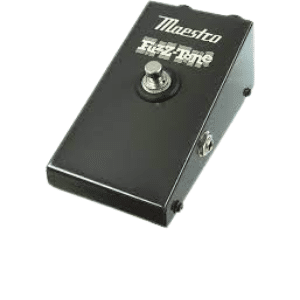
I didn’t know it then, but this unit was the actual stompbox that Richards used on the album since it was the only commercially available distortion effect at that time! I remember thinking it was odd that it had a built-in cord sticking out the box to plug into the guitar.
Eventually, this cord wore out and became noisy. I cut it off the unit and installed an input jack in its place.
This was my very first stompbox, and all these years later, I have bought dozens more of them, so be forewarned that collecting these little devils can be very addicting, in a good way, of course!
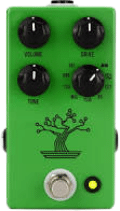
How To Use A Stomp Box
One of the most endearing features of stompboxes is that they are very straightforward to use. To get up and running simply put the stompbox in the signal path, either between your guitar and amp or in the effects loop (more about this later).
Select the stomp box’s sound characteristics by adjusting the knobs and activate or deactivate the sound effect by “stomping” on the box’s off-on switch (or switches).
Some stomp boxes also have lights to indicate when the unit is activated, which may not always be easy to hear if the effect is subtle and you are using multiple effects simultaneously.
When To Use A Stomp Box
It’s easy to get carried away and turn on all your stompboxes all the time, especially when you first start playing the guitar. Try to use effects sparingly and only when they truly enhance a particular part of a song.

Don’t use effects like distortion, sustain, or echo to try to make yourself sound better than you actually are. I did this when I first started out but soon learned that the only way to become a better player was with dedicated practice.
Some of the best players in the world just plug their guitar straight into their amp and let their “fingers do the walking and the taking.” if you can sound good without effects, then stompboxes will really make your music stand out!
Robben Ford is one guitar player that minimizes the use of stomp boxes and always sounds fantastic! See Robben Ford Ohne Filter 1993 DVD Review – An Amazing Concert.
Buying Your First Stomp Box
Once you have decided to go ahead and take the plunge and the choice isn’t already a “no-brainer,” there are some things you will probably need to consider before taking one of these bad boys home with you.
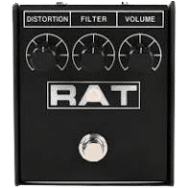
- What type of music do you play most?
- Which stompbox will be most helpful for this style of music?
- What stompbox configuration are you looking for (single-effect, multi-effect, etc.)?
- Which stompbox will work best with the amp you have (vintage, high-gain, etc.)?
- How much money are you willing to spend?
Consider starting with a rudimentary type of effect first, like reverb, overdrive, or distortion, because you can use it to play the most songs. Don’t be taken in by the appearance of the stompbox, although some do look wicked-cool! How it sounds is way more important.
One of the best ways to choose a stompbox is to go to a music store and try as many as it takes to find the one that’s right for your particular needs. You can always buy it online at a lower price if the store owner or manager is unwilling to negotiate a sale.
When I was in high school, I went to the local music store to try out a Fender Bassman head and cabinet. During the sales negotiations, my drummer kept jumping up and down and screaming, “get it, get it!” If you can, always go alone.
Adding More Effects And Using A Pedalboard
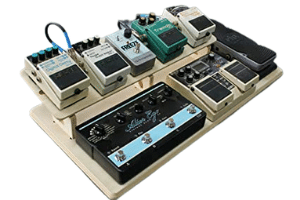
If you are anything like me, it won’t be long before one stompbox turns into two. Did it clone itself, or are you becoming “stompbox crazy,” no matter, because it’s all part of the fun of playing guitar!
When you collect enough of these little beauties, you will probably want to start thinking about getting a pedalboard to keep them organized and powered without batteries.
Pedals work great with wireless guitar systems! For more info, see Wireless Guitar System Pros & Cons – Is It Your Best Bet?
Pedalboards are available at a wide range of prices, depending on sturdiness and functionality. The two major considerations are how many stompboxes you need it to hold and the power supply quality.
A power supply with low-quality voltage regulation or noise filtering will only become more trouble than it is worth in the long run. Ask other guitar players what pedalboard they use and read reviews online before you buy.
Pedalboards come in single or multiple-tier configurations. The pedalboard in the image above has two tiers. Always place the stompbox pedals you use the most on the lowest tiers for easy access.
Stompboxes are most commonly adhered to the pedalboard using velcro strips so they can be easily removed and reattached.
For more information see EBII Pedalboard System Review – Simplify Your Pedal Setup!
Custom-Made Pedalboards

Custom-made pedalboards are pricey items that have the stompbox components built right in. They are usually made from high-end military-grade parts to make them fail-safe with a very high signal-to-noise ratio (i.e., super quiet).
They can be designed to your exact specifications, and you can choose the effects that you want.
Get your own board custom-made after you go pro, for when you play those huge arenas and stadiums. In the meantime, don’t quit your daytime job. 🙂
For information on the pedalboard that Pete Cornish designed for Jimmy Page, see Led Zeppelin Celebration Day Review – Their Fabulous Return!
Stomp Box Configurations
Quite a bit has happened in the evolution of stompboxes since the Maestro Fuzz-Tone, which was the analog device that set the standard and started it all.
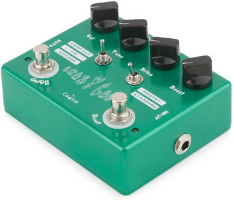
Single-Effect Vs Multi-Effects Stomp Boxes
As guitar players began daisy-chaining multiple effects together to create their sound, “multi-effects” boxes began to appear. The first ones were custom-made and then commercially available.
These “all-in-one” boxes were quicker to set up without connecting patch cords and made combining effects somewhat less noisy.
Analog Vs Digital Stomp Boxes
As digital units eventually supplemented all-analog stompboxes, it quickly became apparent that each type had its pros and cons. While digital units gave players more control over their effects and were usually less noisy, analog effects tended to sound more “organic.”
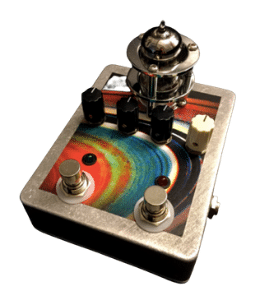
To address the issue of thin-sounding solid-state or digital stompboxes, some manufacturers actually started adding tubes to their units to make them sound better and have a more dynamic response to the way notes are played.
One downside of these effects units is that they cannot run on batteries. They require their own dedicated power supply to operate correctly.
You can see how using too many of these stompboxes without a shared power supply could get a little messy in the wiring department.
Hybrid (Analog And Digital) Stomp Boxes
The Ibanez PUE5 is an example of a hybrid (analog and digital) multi-effects stompbox. I used this unit for years and still have it. It has an analog compressor, distortion, and chorus effect, with a digital delay. There is also an “external loop” feature to add more analog or digital stompboxes.
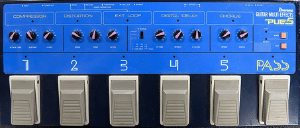
The nice thing about this effects unit is that you just twist some effects knobs and you’re good to go, no programming of settings. It’s like having a whole string of separate stompboxes in on a single board.
Very quick to make setting changes on-the-fly, just the way a guitar player likes it! Notice the “Pass” pedal, which bypasses all the currently activated effects so you can take the effects out of the audio signal in one easy stomp.
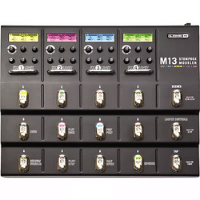
.
“Modeler” Stomp Boxes
In an effort to make digital stompboxes more versatile and natural-sounding, stompbox “modeling” units were invented. This technology could model various new and vintage stompboxes and create novel sound effects by simply twisting knobs and programming the setting into various switches on the unit.
The first modeling units were only able to create a gross approximation of the original stompbox’s sound. Today you can buy “high-definition” effect modeling stompboxes that sound great and respond more accurately when you play through them.
The Line 6 M13 is an example. It allows you to use up to 4 effects simultaneously and save up to 48 effects arrangements! Hey, if that’s not enough, you can always run two of these pedalboards side-by-side! 🙂
See Fender Champion 20 Review – All You Need In A Practice Amp! for my review on a very affordable amplifier with 12 digital amp models and 12 digital effects models, all built into an effects loop configuration!
Types Of Stomp Box Effects
Stompboxes are grouped according to their basic design and function. Here is how they are classified.
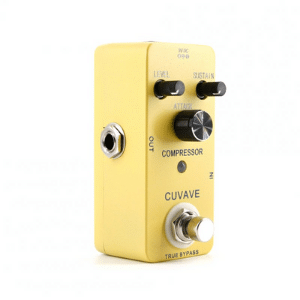
Compressors
Compressors use dynamic range compression (DRC) to increase the volume level of notes that are played softer than a preset threshold and decrease the volume level of notes that are played louder than a preset threshold. This gives you a very even sound with more sustain and clarity.
To learn more about how a compressor works, see JangleBox JBX Compressor Review – Is It Better Than The JB3?
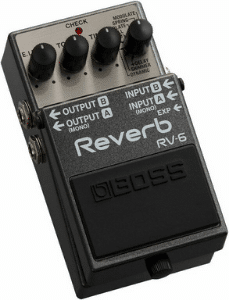
Reverb
Reverb can make your music sound bigger and more “dimensional” by having the notes you play seem to persist after they initially ring out. It’s like the effect you get if you sing in the shower, which always seems to make you sound better. Check to be sure that your amp doesn’t already have a built-in reverb circuit before you buy a separate stompbox.
For more info, see Donner Reverb Pedal Review – Affordable And Easy To Use!
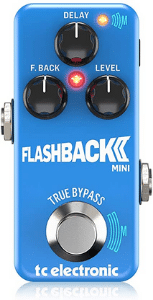
Delay
Delay is like the next step in the evolution of reverb, making it sound like an echo. Delay stompboxes record a guitar signal and then play it back after a period of time has elapsed.
The delay can be any time duration from barely noticeable (“slapback” echo) or so long that an entire guitar riff can be played back a second time by the stompbox. The delay intensity can also be varied to make it louder or softer compared to the original signal.
For more info, see Donner Echo Square Review – This Pedal Hits The Jackpot!
Overdrive And Distortion
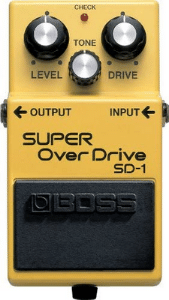
Overdrive and distortion stompboxes work by increasing the audio signal’s volume level before entering the amplifier’s pre-amp circuit.
This flattens (“clips”) the signal’s peaks and troughs to create the desired sound. You can have anything, from minimal crunch to full-blown distortion, depending on the stompbox, your amp, and how much they boost (clip) the pre-amp.
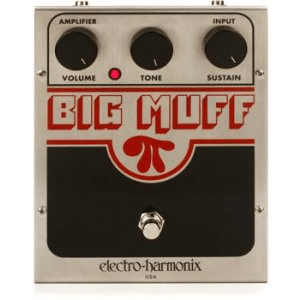
If you want just a subtle boost to your guitar signal to increase sustain and make your guitar solo “sing,” then an overdrive stompbox is probably your best choice.
Distortion and “fuzz” stompboxes will give you a more aggressive sound but usually at the expense of tone and note clarity, especially when playing chords.
I still have the original version of the Electro Harmonix “Biff Muff Pi” distortion box. I bought it on the way home from a Black Sabbath concert when I was in high school. Killer distortion and sustain until you decide to take your finger off the string!
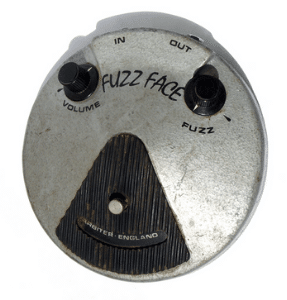
Let’s not forget the most famous distortion box of all time, the legendary “Fuzz Face!” Arbiter Electronics made it, and it first hit the market in 1966.
Only the original units were made with germanium transistors. Later on, they were made with silicon transistors, and their sound changed.
Jimi Hendrix used an original germanium Fuzz Face and made it the sound heard around the world! Jimi was inducted into the Rock And Roll Hall Of Fame in 1992. For more info, see Rock And Roll Hall Of Fame – The Killer Guitar Players!
Also, see Mesa Boogie Flux Drive Review – Get Great Overdrive!
If you want to read about a truly innovative product, see Wampler Sovereign Distortion Pedal Review – Make Solos Soar!
To read more about the Fuzz Face and Eric Johnson, see Eric Johnson Live From Austin TX Review- This Concert Rules!
See Best Ibanez Tube Screamer Settings For Overdrive & Distortion for more info.
Modulation
These stompboxes all “modulate” or vary the input signal of the guitar repetitively. The most common modulation effects are tremolo, chorus, phase shifter, and flanger.
Tremolo
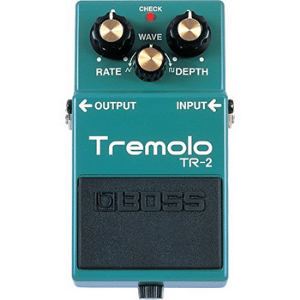
Tremolo creates a rise and fall in the volume (amplitude) of the notes played on the guitar. This creates a mechanical-sounding “in-and-out or warbling-like” effect on the notes you play. Be sure to check that your amp does not have a built-in tremolo circuit before purchasing a unit.
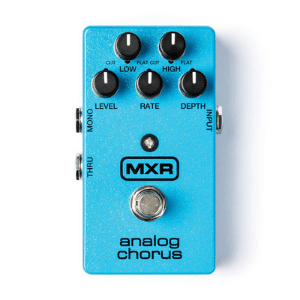
Chorus
Chorus stompboxes mimic the “chorus effect” of vocalists by taking the audio signal from your guitar and mixing it with one or more copies that have been pitch modulated (pitch rises up and down) or delayed.
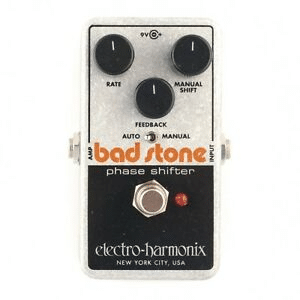
Phase Shifter
Phase shifters create a more “waxing and waning” sound by adding a series of high and low-frequency sounds to your original guitar signal. When set to function aggressively, they can produce a much more “synthesized or electronic” sound.
This Electro Harmonix “Bad Stone” phase shifter does an excellent job and can be set to sound very musical. I have used one for years. I absolutely love their products!
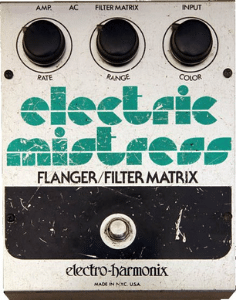
Flanger
Flangers work by duplicating what you play and mixing the two identical signals together with the second signal delayed by a small and gradually increasing or decreasing amount. This effect produces a characteristic “swooshing” or “sweeping” sound.
You guessed it; I wouldn’t be caught dead without my Electro Harmonix “Electric Mistress” flanger! Try one; you’ll love it!
The best way to understand the difference between the sound of a tremolo, chorus, phase shifter, and flanger is to hook them all up together and compare one against the others.
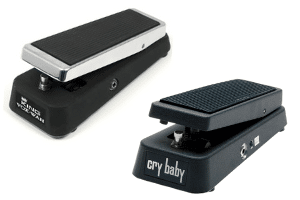
Wah-Wah Pedal
A Wah-Wah is a type of stompbox that uses a pedal to modulate a guitar signal’s frequency, giving it its well-known “wah-wah” classic sound. Think, the opening riff to “Voodoo Child Slight Return” by Jimi Hendrix, on his Electric Ladyland album.
Most players get either a Vox “King” or a Dunlop “Cry Baby” Wah-Wah pedal. Once you get one, you’ll have to have the other – you’ll see!
Did I mention that they can double as a treble booster?
Specialty And Uncategorized Stomp Boxes
These are stompboxes that are custom-designed to make strange sounds. They should be one of the last types of stompbox you purchase because they can only be used effectively in certain songs.
Octave dividers and harmonizers belong to this group, like the Octavia and Uni-Vibe effects, which allowed Jimi Hendrix to create one of his signature sounds. They were used again at a later date by Robin Trower.
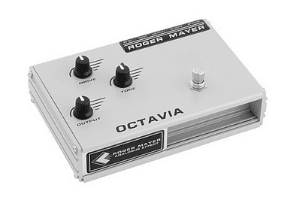
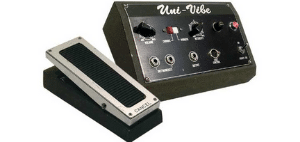
Purchase at least one overdrive/distortion, modulation, and reverb/delay stompbox before adding a specialty stompbox to your collection. When you get all your basic effects, then consider adding one or two effects that you really won’t use all that often. After all, what is a stomp box hoard without a few odd ducks to spice up the mix?
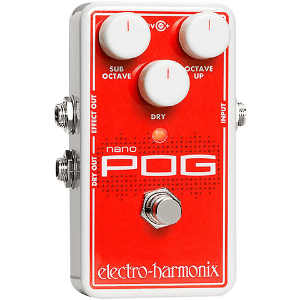
One of my favorite specialty stompboxes is the Electro Harmonix Nano Pog (polyphonic octave generator). This pedal can make some very bizarre but totally musical sounds that you may not even know existed! With this unit’s polyphonic ability, you can even play chords one octave above or below the actual pitch.
Yeah, baby!
To learn about a looper, see the Boomerang Phrase Sampler in the effects section of John Scofield Live – The Best Jazz Fusion Video Ever!
To see a list of stompboxes that Ritchie Blackmore has used, check out Ritchie Blackmore Music – Black Masquerade DVD Review!
What About A Homemade Stomp Box?
There are usually two reasons that guitar players make a homemade stomp box. The most common reason is to save money, and who doesn’t like keeping money in their pocket, especially if it is in short supply!
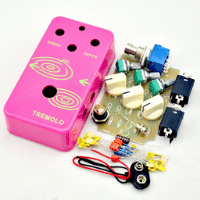
Many do-it-yourself effects kits on the Internet contain all the parts you need; just add a little patience. A generic kit is available for every type of commonly used effect. Many of the specific models that the brand name companies market also have kits, but they typically more expensive.
The second reason to build one yourself is to modify the design on a stomp box that you really like but have an idea to make it better. Schematic diagrams are readily available for many commonly used effects. Some players have the electronics or engineering background to design an entirely new unit from scratch, and how nice is that?
Connecting More Than One Stomp Box To Your Rig
If you begin to use more than one stompbox, it is important to understand the best way to connect them to your amp.

Overdrive and distortion stompboxes should always go between your guitar and amplifier input jack. Never place these stompboxes in the effects loop of your amplifier
Modulation (tremolo, chorus, phase shifter, and flanger), reverb, and delay stompboxes should ideally go through the effects loop (send and return jacks) of your amplifier. If your amp doesn’t have an effects loop, place them between your guitar and your amp instrument input jack.
Reverb and delay stompboxes sound best at the end of your signal chain, with or without the use of an effects loop.
A compressor should always be at the beginning of your signal chain, or just behind your tuner and wah-wah pedal, if you use one.
If you use multiple stomp boxes on a pedalboard, it’s a good idea to use a power conditioner and sequencer. For more info, see Rockn Stompn RS-4 Review – Add A Power Sequencer To Your Rig.
Here is a summary of how you should arrange your stompboxes, depending on your amplifier’s configuration.
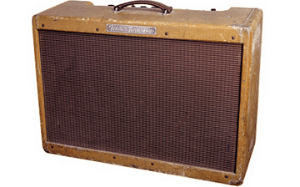
Amplifiers Without An Effects Loop
guitar -> Tuner -> Wah Wah Pedal -> Compressor -> Overdirve/Distortion -> Modulation (tremolo, chorus, phase shifter, & flanger) -> Reverb/Delay -> amplifier input jack
For an incredible amp without an effects loop, see Supro Delta King 10 Review – Great Vintage Class-A Sound!
Amplifiers With An Effects Loop
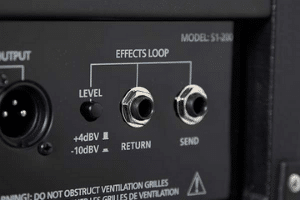
Effects Loop
If your amp has an effects loop, put your stompboxes in two separate signal paths using the following order and configuration.
Signal Path 1: guitar -> Tuner -> Wah Wah -> Compressor -> Overdrive/Distortion -> amplifier input jack
Signal Path 2: amplifier effects loop “SEND” jack -> Modulation -> Reverb/Delay -> amplifier effects loop “RETURN” jack
The effects loop “send” and “return” jacks are will be on the backside of the amplifier.
Related Article ➡ Why Do Guitarists Use So Many Pedals – Little-Known Secrets!
Related Article ➡ Pedal Vs Amp Distortion And Overdrive – Which One Is Best?

Final Thoughts
Stompboxes are miraculous little devices that sit on the floor and instantly change the sound of your guitar with a single press of a switch. They come in a wide variety of configurations and functions for every possible use.
Stompboxes have literally helped change how the electric guitar is played and the sound of almost every musical genre.
Some guitars actually have effects built right into them, like certain Sky Guitar models. For more info see Uli Jon Roth Sky Guitar Review – Fabulous To Behold And Play.
Stompboxes can run the gamut from the very simple analog “set and stomp” units to the more “time-consuming to program” stompbox effect modelers. The simpler units are generally better suited for live playing, while the more complicated models are more useful in a recording studio.
Never allow “overly complicated” stompboxes to replace your precious guitar playing time with “device-fiddling” time.
Start by buying the stompboxes you will use most for the type of music your play. How far you want to take it from there is up to you, but it can quickly become an addicting (and expensive) little venture.
For a great pedal that will give you vintage no-master volume British amp sounds, see DryBell The Engine Review – Get Killer Vintage British Tone!
At some point, you will probably need a pedalboard to organize and power all your little units. Here is a video from Guitar World that shows you how to build two sizes of pedalboards. Select the one that best fits your needs.
Related Article ➡ Can You Use Single Coil Pickups For Rock? – Ultimate Guide!
Related Article ➡ Why Do Guitar Amps Have 2 Channels? – Are 2 Better Than 1?

Stompboxes can change the way you play or perform a piece of music, for better or worse. Properly used, they can take you in a new and more creative musical direction.
Never let stomp boxes get in the way of the process of making music. Some of the greatest guitar players, like Roy Buchanan, don’t even use them. For more info about Roy, see Live At Rockpalast, 1985 – The 5 Best Roy Buchanan Songs, and Fender Tone Master Review – Check Out The New Super Reverb!

Tell Us What You Think
Please let us know what’s on your mind in the comment section, or if I can help you with anything.
- Do you have any additional tips or suggestions?
- What stompboxes are you currently using, and which is your favorite?
- After reading this article, are you considering adding a stompbox to your setup?

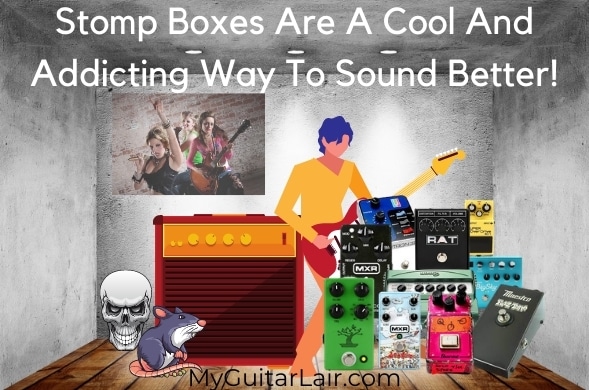

Thank you so much, Frank, for this excellently written article.
You have made my day, I have bought a stompbox a couple of months ago, but after using it a couple of times I laid it aside. I used it mostly for practice, I played a riff and put it in a loop. Boring I know. I never thought there were so many differences in the stompboxes. Now I am on fire I will try to make my own pedalboard and really have fun playing my guitar. Thank you so much for this explanation.
Monique
Hi Monique,
Thank you for your comments!
It sounds to me like you bought a looper pedal. These pedals are really great for practice and songwriting! Try recording a chord progression, like I, IV, V in the key of E (E chord, A chord, B chord), then play your guitar riffs in the key of E over that chord progression.
Let me know what kind of music you play, and I can make some recommendations on which pedals you should consider buying next.
It looks like you have already started to develop a “stompbox addiction,” so join the club! 😊
Be sure to bookmark my website because there will be many articles forthcoming that will really help your playing!
Have Fun!
Frank
Thank you so much for this article about guitar stomp boxes. I always wondered what these things were when I saw people playing, and never really used one myself. I love that they are the reason that there are so many cool sound effects, but I agree, it should not be used all the time, and only sparingly, as the guitar should sound natural in my opinion, most of the time.
Hi Jessie,
Thank You for your comments!
If you play electric guitar, consider trying a basic type of stomp box, like reverb or echo. You can adjust them both to sound very subtle, and either one of these would make your music sound more “dimensional.”
Frank